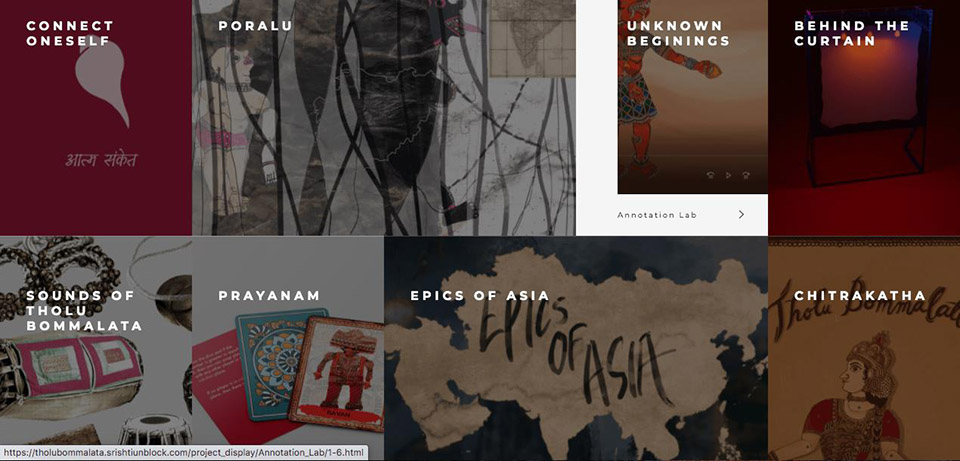"To design is much more than simply to assemble, to order, or even to edit: it is to add value and meaning, to illuminate, to simplify, to clarify, to modify, to dignify, to dramatize, to persuade, and perhaps even to amuse. To design is to transform prose into poetry.” - Paul Rand

Documenting conversations with craft communities through UI, visual and motion design of a website for Unblock 2020 (https://srishtiunblock.com/). Image Source: Adharapurapu Vinod
Vision
The vision of the 3-year program in User Interface and Interaction Engineering is to train aspiring practitioners to develop exceptional skills to craft high-quality, professional interface designs and interactions across multiple media.
Humans increasingly employ and interact with technologies as they go about their daily lives to get things done - and all this happens through interfaces. Thus, the key to success of any product or experience today - be it an application, website, game or a virtual reality experience - is effective and well-crafted interfaces, and thoughtful interactions. This aspect is at the heart of increasing number of design-driven organisations offering digital products and services.
The focus of learning is on the tools, standards, frameworks and methods of creating, documenting, and communicating interface design across web, mobile, gaming, augmented and virtual reality platforms. The orientation it to respect both the growing demand for skilled designers in the industry as well as the increasing requirement for accountability and responsibility that is expected from both designers and designed experiences.
The program is geared to train professional practitioners who can undertake job responsibilities within small and large organizations, with skill sets that range from Visual Prototyping, Motion Design, User Interface Design, Web design, Mobile App Design, User Testing, Front-End and UI development, etc.
Sector
Media-Entertainment
The three years of this course align with the Levels 4, 5, 6 and 7 of NSQF guidelines and creates skilled employees for the Information Technology - IT enabled Services Sector and Media-Entertainment Sector.

Interacting with Industry mentors to understand workflows and design principles during industry exposure visits.
Core Values
- Professional
- Persevering
- Pragmatic
Course Structure
The core principles that govern the design of the unit are as follows:
Mastery Learning with Guided Practice breaks down competences or skills into subskills, methods and techniques. Through targets taught through modelling and direct instruction followed by guided and independent practice, mastery of core competences and skills are achieved.
Work Related Learning is the co-design of opportunities/projects by industry based professionals or employers or other stakeholders on the one hand and faculty on the other. Guided and facilitated by mentors this space allows for future employers to participate in the learner’s journey.
Industry Linkages includes both exposure, orientation and direct interactive learning in real time contexts. This is towards specific jobs and roles, as well as work experience within each course’s respective industrial sector. Linkages between academic institutions and creative industries is inclusive of both economic and social benefits of innovation.
Fab. Ateliers build on the values of thinking, modelling and making to challenging design contexts drawn from indigenous knowledge and / or tools from digital technology.
Public Labs are open spaces that foster DIY thinking along with citizen science and other initiatives to build a culture of learning that is self-initiated, independent and collaborative. Public Labs are open to all learners for purposes of self-study, learning, archiving and developing personal interests in technologies.
Bootcamps foster accelerated learning of concepts, skills and technologies that are directly linked to either employable, entrepreneurial or livelihood based skills. Working through immersion, with a focus on hands-on problem solving and peer learning rather than instruction.
Hackathons can range from competitions or events over days to half-day jams or a one day hack-fest. This format encourages brainstorming, pitching of concepts, working in teams and also planning projects as well as development of prototypes.
What you will learn
YEAR 1
In the first year, the focus is on efficient and rapid production of high fidelity design and prototypes of interfaces for web and mobile using professional software tools, as well as gain abilities to design animations and transitions. Furthermore, they will also develop basic programming abilities. In semester one, students will learn the basics of visual and interface design, as well as prototyping interfaces. Semester two will cover animations and transitions and basics of programming.
YEAR 2
In the second year, the focus is on developing professional level abilities of performing the role of a designer across the multiple job positions in the industry, such as usability engineer, motion designer, data visualizer, UI designer, front end programmer, etc. In semester three the students focus on testing interactions and working and visualizing quantitative data through programming. In semester four the focus is on developing their individual job role through working on an industry brief to produce and efficiently contribute to a particular production chain.
YEAR 3
In the third year, the focus is on working with the industry in a context of the student’s choice so as to gain an in-depth working proficiency of contributing to the production of exceptional interfaces for the web. The goal is to enable students and industry to work together and potentially induct the students into their ready workforce. Semester five will focus on industry training through ‘industry experience’ and mentor lab, leading into a capstone project in semester six.
People
Enquiries

FAQs
User Interface and Interaction Engineering focuses on the wide range of creative processes and practices that enable the conception, iterative design and development of exceptional, engaging and desirable human-digital system interactions. As technological media widen the possibilities for designing for and across them is a challenge for an emerging workforce. UIIE aims to address this challenge by equipping you to be a nimble creator and digital craftsperson.
This course is suitable for you if you
- Love to seriously tinker with and shaping the digital materials such as code, data, screen, sensors, input devices, etc. for people’s use,
- Are driven by the purpose of solving problems people face while interacting with digital systems,
- Are excited about industry settings, processes and practices to give life and realise design,
- Are a diligent and quick learner, and one who works well with teams with a common purpose.
You will learn the basic fundamentals of user interface and interaction design, programming, and working with and visualising data. Based on these fundamentals you can then pursue dedicated learning journey within the complex world of UI/UX design industry, and across multiple media forms.
Please download the course prospectus to know about the specific learning units that will be taught in this course.
You will be able to wear multiple hats, as someone who ideates and conceptualizes or who is technically capable to execute those ideas. You will work with product and services development teams that create cutting edge interfaces and interaction designs for digital products for the web across established corporate design studios such as Swiggy, Furlenco, Tata Elxsi, Uber, etc., design firms, and design and technology incubators working with cutting edge and emerging technologies.
You will, based on the paths of learning you take, play a range of following roles:
- ensure that current and future user needs are met; design delightful, useful and user friendly product interactions and / or data visualizations; test products so that they meet the users’ expectations, constraints and needs; iterate and prototype to deliver development ready interfaces and visualisations.
- You will be able to contribute in the areas of interaction and user-interface design at numerous MNCs, startups, R&D centres across India and abroad, involved in developing technology-based products, interfaces and services. Possible job titles can include User Interface Designer, Product Designer, interaction designer, Motion Designer, UX Copy writer, Data Visualizer, Front-End Developer, etc.
This course will also open avenues for higher education in art, technology and design.
The course differs from other courses in the following manner:
- The curriculum is aimed to address the current as well as emerging needs of creative industries.
- Curriculum is co-designed with industry partners, and is linked to the specific expectations from the NSQF for the sectors of Information Technology - IT enabled Services and Media-Entertainment.
- Learning happens through multiple modes that include direct and extended interactions with industry, not limiting to corporate design firms, but also exciting and emerging start-ups working with new forms of technology.
- The focus is on hands-on crafting, doing, and making in a purposeful and responsible manner.



